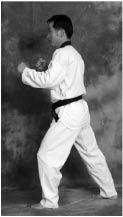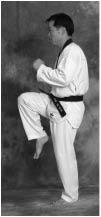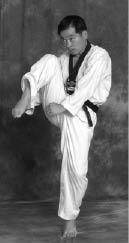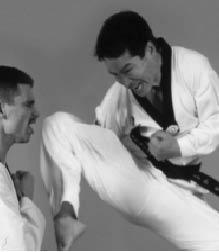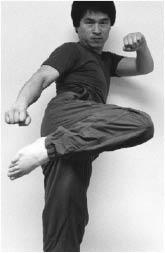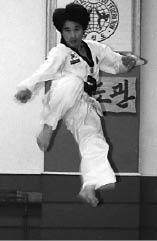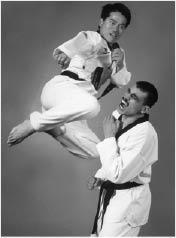Complete Kicking (11 page)
Authors: Turtle Press

TIPS FOR HIGH SIDE KICK:
You should be practical with side kick; generally, you do not need to kick higher than stomach level. However, if you want to improve the height of your side kick, here are some exercises you can do:
1) Do low horse riding stance for 60 seconds (photo 2). Rest for 30 seconds.
2) Do a deeper horse riding stance for 60 seconds.
3) Squat down and hold your ankles. Breathe deeply for 60 seconds.
4) From step #3, put both hands on the floor in front of you. Slide your right foot all the way to the right and stretch your right leg for 60 seconds. Repeat with the left leg.
5) Stand up and walk around while breathing deeply and shaking your legs and ankles to loosen up the muscles and joints.
6) Hold a bar, chair or table for support, and raise your right leg for a slow side kick. Hold in the air as long as you can. Repeat on the left side. Do a minimum of 3 sets of 15 seconds on both sides.
7) If your have a partner, let him hold your leg and raise it slowly in side position to a little past the point where you are comfortable. If you don’t have a partner, you can use a wall (photo 3) to support your kick. Repeat 3 times on each side, holding for 15 seconds each. Eventually you might be able to use a door frame for this exercise (photo 1)
Repeat steps #1-7 three times a week for twelve weeks. Monitor your progress weekly by keeping a journal so you can see your progress over the three month period. It is important to know your limits and progress from there. As long as you are making positive progress, where you began from isn’t very important.
KNEE KICK
purpose
Knee kick is used to strike an opponent in close quarters or ground fighting. The main goal of knee kicking is to systematically drain the opponent’s energy and will by inflicting pain on exposed targets like the thigh, rib cage, stomach and groin. For advanced practitioners, a jumping knee kick to the head can be a deadly weapon.
key points
Secure the opponent by holding his neck, head or torso before kicking. Precisely attack vital points such as the groin, outer thigh, and rib cage.
striking area
Upper knee, frontal knee, inner knee
targets
1. groin
2. lower abdomen
3. solar plexus
4. sternum
5. head
6. rib cage
7. thigh (outside, inside)
8. knee
how to
1. From fighting stance, shift your weight to the front leg.
2. Raise your knee toward the target.
3. Snap the pelvis and thrust the knee upward while pulling down with your hands and sharply exhaling as you tighten your abdomen muscles.
4. For repetitive knee strikes, set your foot down toward the rear of your stance. For combination strikes, set your foot down in front, close to the opponent.
FRONT VIEW: Begin practicing with a mid-height knee kick. Hold this position for 15 seconds at a time to develop pelvic control.
JUMPING KNEE KICK
A jumping knee kick is one of the most advanced fighting techniques. When you deliver a jumping knee kick, keep your head up, focus your attention on your lower abdomen, and try to form a triangular shape with your body (your striking knee is the tip of the triangle). Notice how compact the body is at the moment of impact.
variations
Knee kicks vary from style to style and performer to performer. You can kick vertically, horizontally or diagonally, upward, downward, inward or outward. Or you can kick in some combination of the above. The knee kick is the most versatile kick, particularly in combat sports.
BOTTOMLINE: Strive to develop absolute pelvic control to manipulate the direction and force of the knee kick.
Straight upward knee kick
Roundhouse knee kick to the middle section
Jumping roundhouse knee kick
Jumping horizontal knee kick
Other books
Fan the Flames by Rochelle, Marie
Planet Of Exile by Ursula K. LeGuin
The Empire of Shadows by Richard E. Crabbe
Nothing but a Smile by Steve Amick
La gran caza del tiburón by Hunter S. Thompson
After This by Alice McDermott
Coach by Alexa Riley
The Untamed Mackenzie by Jennifer Ashley
The Lightning Catcher by Anne Cameron
Death Falls by Todd Ritter
